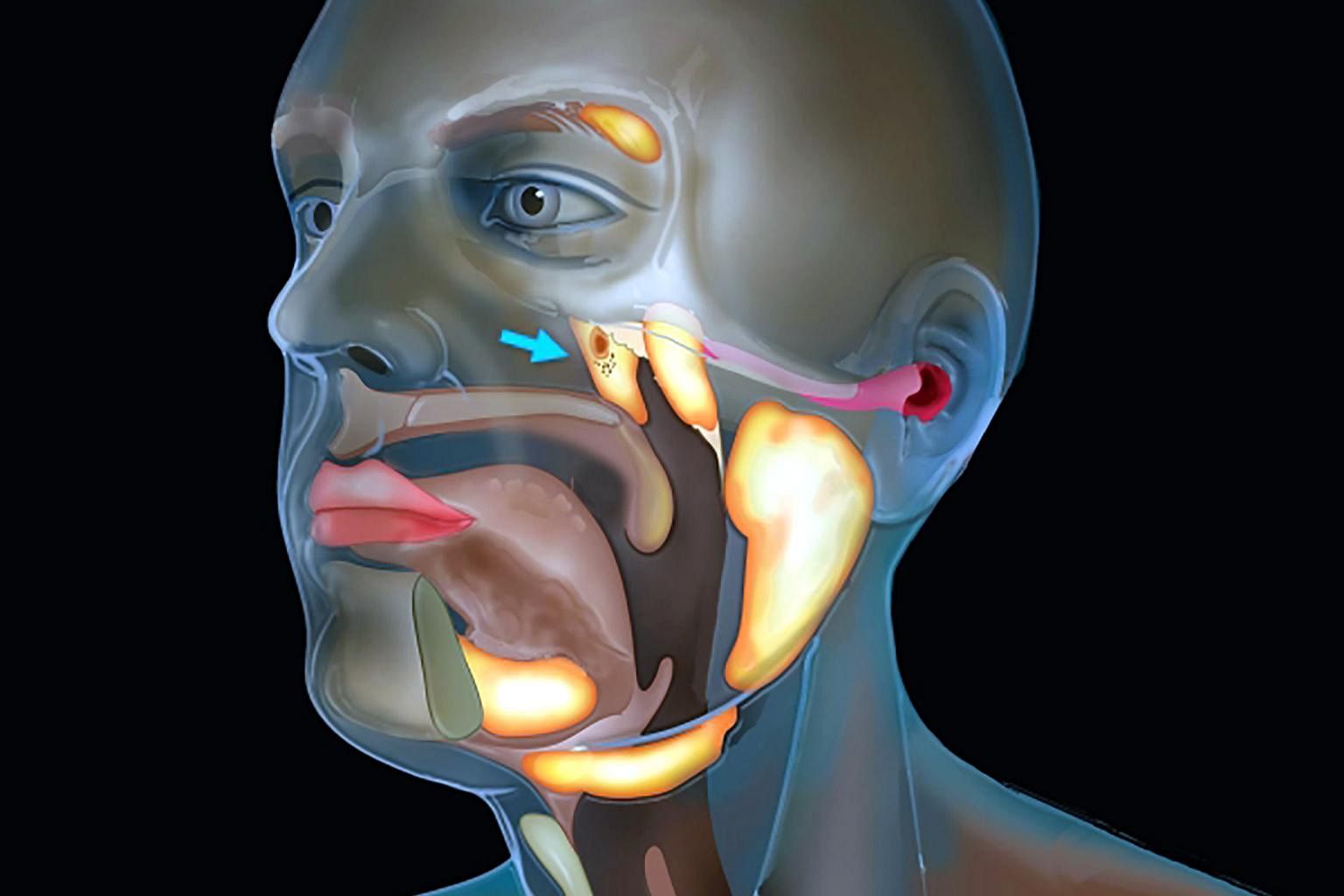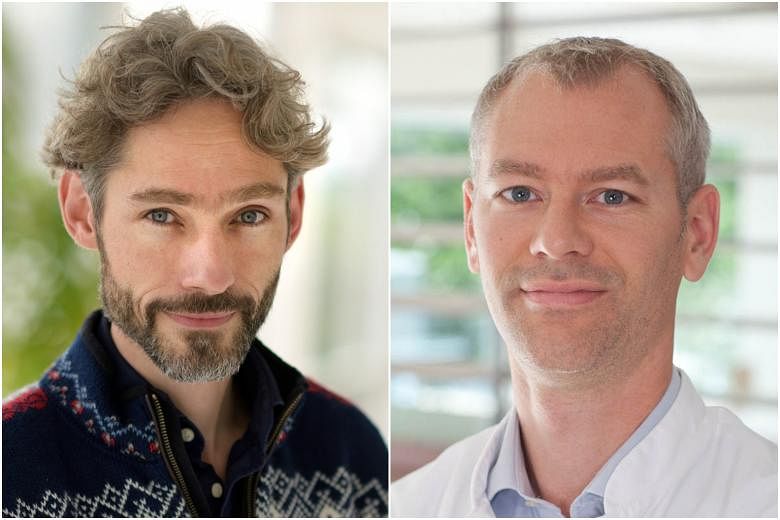Puzzlement turned to wonder when a group of Dutch doctors who were carrying out cancer research stumbled upon a pair of new salivary glands.
It was a feat made possible by their curiosity and new technology.
The doctors from the Netherlands Cancer Institute (NCI) in Amsterdam were in 2017 studying scans from prostate and urethral gland cancer patients, which pinpointed pools of cancer cells in the body. The specialised scans detect salivary glands as well.
When they called up the first images of the patients' head and neck regions, they expected to see the three known pairs of salivary glands near the ears and jaw light up in orange.
But they were surprised to see a pair of curious-looking spindly structures smack in the middle of the head glowing too. The structures had never been seen before.
"At first, we thought... it's not real. Or maybe it was some sort of tissue. But it looked a bit like a salivary gland, and then we wondered if it is a salivary gland," said Dr Wouter Vogel, a radiation oncologist at NCI.
All 100 scans - 99 from males and one from a female - detected the hook-like pair lodged in the area where the nasal cavity and throat meet. The average length of each tissue was 4cm.
"We were confused and surprised by this finding, and we wanted to investigate this further, to make sure they are indeed salivary glands," added Dr Vogel.
The doctors set aside their original research and became organ Sherlocks. They pored over old anatomy books and manuscripts, and found that some anatomists have recorded a higher density of microscopic cells at the same area the pair of tissues is located, said Dr Matthijs Valstar, a surgeon at NCI who deals with defects and diseases affecting the face and neck.
Both Dr Vogel and Dr Valstar led the research team which comprised members from NCI and three academic hospitals.
The scan images could only provide so much information. They needed to work with the real tissue.

The doctors obtained it from two bodies that came to them from a body donation programme.
A closer look under the microscope and 3D modelling showed parallels between the tissue and known salivary glands: mucous glands with draining ducts, the presence of enzymes, glandular tissue, and a type of protein found in salivary glands.
Pieces of the puzzle were coming together.
"We thought there were enough arguments to call it a salivary gland. But it could also be a collection of minor glands that are really dense and clustered," said Dr Valstar.
On top of the three major pairs of salivary glands, roughly 1,000 minor salivary glands are dotted throughout the mucus membranes of the head-neck area.
"But the important thing is (the new salivary glands) seem to have a role in lubricating and moistening the nasal pharynx, the upper part of the throat," he added.
The researchers tagged the new glands as part of the salivary gland organ system.
In mid-March last year, the researchers went public with their discovery at a head and neck oncology conference in Barcelona.
The audience, mostly cancer experts from Europe, were sceptical at first, but became convinced as the team piled up the evidence.
Dr Vogel said: "Many in the audience agreed that they were salivary glands, and they deserved a name."
The researchers called the new tissues tubarial glands, and published a paper on the discovery in scientific journal Radiotherapy and Oncology last month.
Knowledge of the human body had exploded since the heyday of interest in it in the 17th century.
So, what are the chances of discovering new organs or organ parts these days?
Science Centre Singapore's chief executive, Associate Professor Lim Tit Meng, said: "This finding shows us that there is much more for us to discover especially in areas we think we are very familiar with."
He said while finding a new organ or body part is rare nowadays, there are advanced visualisation technologies and new tracers that allow scientists to examine finer structures that have escaped traditional anatomical studies, he said.
Likewise, the tubarial glands had nowhere to hide due to better imaging technology.
The specialised scan the doctors used was only developed about five years ago. The prostate-specific membrane antigen (PSMA) Pet-CT scan is more sensitive compared with standard ones such as Pet, CT and MRI.
"Those scans (Pet and MRI) look at tissues and anatomy, but not at individual cells. But the PSMA Pet-CT can detect a smaller volume of tissue, and it can also detect more difficult locations with complex anatomy," said Dr Vogel.
Dr Valstar added: "This particular gland structure is in the middle of the head. It's not easy to access, and it is really thin. If somebody has a tumour there, it's really hidden."
The doctors see the new body part as something else to investigate as they determine how the glands affect patients' health and cancer treatment.
Salivary glands get damaged by radiotherapy, a cancer treatment where beams of radiation pierce through the body to kill cancer cells and shrink tumours.
Patients with head and neck-related cancers who undergo radiotherapy suffer side effects such as dry mouth, difficulty swallowing and tasting, and even speaking - although doctors spare the glands from high levels of radiation.
The Dutch researchers said the new salivary glands could explain why patients continue to get those side effects despite precautions. The overlooked glands were never shielded from the toxic rays before.
But the researchers and oncologists in Singapore both agree that the tubarial glands must be further studied before radiotherapy protocols are changed.
"The exact physiological functions of the tubarial glands have not yet been fully ascertained, and the extent of its role in lubricating the pharynx relative to all the other major and minor salivary glands still merits further study," said Dr Natascha Putri, a consultant from the division of surgery and surgical oncology, at Singapore General Hospital and National Cancer Centre Singapore (NCCS).
Dr Kiattisa Sommat, a consultant from NCCS's division of radiation oncology said sparing the glands is not possible in patients who have cancer in the same area or near the area.
Dr Valstar said independent studies in other institutions are needed to prove how much radiotherapy affects the new glands.
The doctors are currently doing lab work to find out more about the internal workings of the new bag of saliva - from the type of mucus it secretes to what proteins it is made of.
Beyond radiotherapy, Dr Valstar said the discovery could shed new light on other health issues such as autoimmune diseases that inflame the glands.
"This (discovery) is a starting point for a new vision and research in this area. It's not an endpoint."


